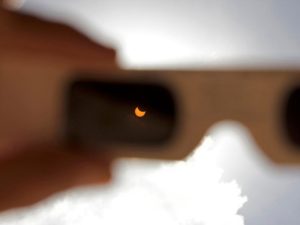America will experience a total eclipse this month. Even if you aren’t in the path of totality on August 21, you will experience a partial eclipse, where the Moon blocks some portion of the Sun. Millions of Americans will be tempted to look up at the eclipse, which violates one of the most basic rules of astronomy: Do NOT look directly at the Sun. This rule always applies, even during a partial eclipse when the Sun looks like a crescent. You can permanently damage your eyes, so don’t do it. Fortunately, there are special eclipse glasses you can get that allow you to watch the eclipse without harming your eyes. Unfortunately, some eclipse glasses aren’t safe to use, so you shouldn’t use any eclipse glasses that haven’t been verified as safe.
The danger of looking at the Sun is partly due to its extreme brightness, but it’s mainly due to two things you can’t see. Infrared and ultraviolet radiation. Infrared light is the type we feel as heat, such as the warmth that radiates from a campfire. If you stare at the Sun too long, its infrared light can overheat your retinas and damage them. Ultraviolet light is what gives us sunburns. Just as our skin can become damaged due to UV exposure, so can our eyes. If you’ve ever experienced a sunburn, you’ve noticed that you aren’t aware of the burn until it’s too late. The same is true with damage to your eyes. You might not notice a problem until you have already damaged your eyes.
Eclipse glasses are designed to block the harmful infrared and ultraviolet light from the Sun. The latest manufacturing standard, ISO 12312-2, allows you to view the Sun safely for extended periods of time. You should still make sure you have sunscreen on your face, but proper eclipse glasses will make sure you won’t harm your eyes. Unfortunately, demand for eclipse glasses means some folks are selling eclipse glasses that aren’t safe. They don’t block enough UV and infrared to be safe. Some of these fake glasses even claim to meet the ISO 12312-2 standard. It takes a special kind of evil to risk blinding children for a quick buck. Unfortunately, this means you can’t simply trust glasses with the ISO standard printed on them.
The only way to be sure your glasses are safe is to confirm the source of the eclipse glasses. The American Astronomical Society has compiled a list of manufacturers verified to be in compliance with the ISO standard, as well as a list of vendors that only sell from verified sources. If your glasses came from this list, then you should be good to go.
https://eclipse.aas.org/resources/solar-filters
Libraries and science museums are also a big source of eclipse glasses. In many cases, they are giving them away for free, particularly to folks who can’t afford them. If you got a pair from a library or science museum, they are almost certainly fine. If you aren’t sure, just contact them to confirm the source. The biggest danger is if you purchased them online from a source not listed on the AAS resource page. They might be fine, but it’s hard to be sure. It’s better to be safe than sorry.
Once you have good eclipse glasses, proper safety is still important. Make sure that the glasses are not damaged or scratched, and don’t look towards the Sun unless your eclipse glasses are firmly in place. Make sure your children know the safety rules and keep your eye on them while they view the eclipse. During the period of totality, you can look at the eclipse without glasses, but only when the Moon completely blocks the Sun.
If you don’t have eclipse glasses on August 21, don’t try using a substitute. Sunglasses are not enough. Welding visors are not enough. Don’t risk your eyes using them. Instead, build yourself a pinhole camera. They are simple to make, and you can watch the eclipse without ever risking your eyes.
Brian Koberlein is an astrophysicist, professor and author. You can find more of his writing at One Universe at a Time.
